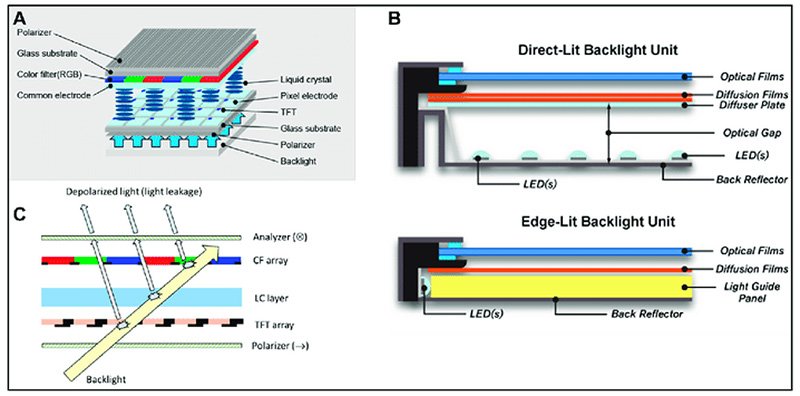Backlighting is an essential aspect of many LCD screens. It illuminates display screens that do not have a lighting system. However, some manufacturers employ certain types of lighting for their brand of LCD.
Edge-lit and Direct-lit displays use two types of lighting to illuminate LCD screens. This article will discuss which is better and might be best for you.
1. The Two Most Common Lightings
Edge-lit and Direct-lit are technologies manufacturers use to illuminate LCD screens and monitors. They are among the vast array of LED technologies developed for various industries. Here manufacturers use them for backlighting LCD screens.
LCDs do not generate lighting, and images through liquid crystals need lighting. That is where Edge-lit and Direct-lit come into play. They illuminate this display technology through advanced technology and light-emitting diodes.
But technology and materials are not the only determinants of efficiency and effectivity in giving consumers the experience they want.
Their position optimizes lighting for generating images. The location of the LED lighting is the primary determinant of the function and effectivity of this auxiliary technology. The two share this, and it makes them different from other display technologies.
Light on The Edges
They call it Edge-lit because the LED lights on the edges illuminate the LCD panels.
Edge-lit has lights in strategic locations to maximize the smaller number of lights. Edge-lit LED displays distribute light proportionally across the display screen.
The number of LED lights in Edge-lit may vary. Some have lights on all four edges, while others have lights only on two edges, which means they also have fewer lights.
The Matrix Formation
On the other hand, Direct lit have LED lights arranged in rows and columns of the display screen. They are such because the lights directly illuminate the liquid crystals, not just by facing lights from a specific direction.
This type of lighting utilizes lighter than Edge-lit, illuminating the liquid crystals directly above them. It puts light on the screen in a matrix-like fashion, providing greater clarity for images due to the superior number of lights.
But how do the two affect the performance of the display technology? Can choosing one over the other impact the viewing experience and aesthetic aspects one can enjoy? Let us delve deeper into what the two displays offer consumers.

2. Comparing the Edge-lit and Direct-lit in LCD
The most significant similarity between Edge-Lit and Direct-Lit is the use of LED technology in LCD screens to provide adequate lighting. However, their actual applications in display technology vary. Depending on your use or the type of consumer, your choice of either may impact your experience.
Here lies the vital differences between Edge-lit and Direct-lit Displays:
Surface Area
The two LED technologies vastly differ in their location and the areas covered. The Edge-lit puts lighting on the edges, while the other is in a matrix-like formation across the display screen.
For the former, sometimes they do not even cover all edges but are strategically located on two sides. It directly impacts the aesthetic aspects of the LCD screen, as we shall see.
Brightness
Even if the Edge-lit covers all edges, it will still be of lesser brightness than the Direct-lit displays. The placement has something to do with it. Since the former are on the edges, the area the lights can cover is far smaller.
That is in direct contrast to Direct-lit, which covers a much larger surface area due to its formation in the LCD screens.
Clarity and Precision Imaging
The location of the Direct-lit display makes the screen brighter. It makes for better clarity and image precision than the Edge-lit. The placement of lights in Direct-lit displays allows for brightness uniformity and optimizes color contrast. The position and the more significant number of lights result in more visible details, excellent precision, and better image quality.
That is even so if the Edge-lit displays cover all the edges, not just strategically positioned for maximum effect. They cannot compare with the Direct-lit ones regarding brightness, color, and image precision.
Weight
LED screens employing Edge-lit technology are lighter than their Direct-lit counterparts. Since they are on the edges, they do not impact the thickness of the display technology. That is not the case with Direct-lit displays, which need to be thicker because the lights need some distance from the screen.
The relative size and thickness of the display technology can enhance the aesthetic appeal. Some people love their gadgets and display technology to be lightweight and slim, and some may sacrifice the immersive experience for the visual appeal of the display technology itself.
Energy Efficiency
LED technology, on balance, is energy efficient. However, since Edge-lit displays use fewer lights and optimize location to give illumination despite fewer lights, they are more energy efficient.
By contrast, direct-lit displays utilize more power because they have lighter than their counterparts. What Direct lit optimizes for lighting, aside from location, is the sheer number of lights. Thus, it uses more power and electricity but still uses them efficiently.
Cost
Though both were products of the LED revolution, edge-lit displays employ fewer lights, which makes them less expensive than Direct-lit displays. More light means more parts and components.
The more lights you have, the more energy your display technology consumes. Thus, Direct-lit displays are expensive because of added materials and because they use more energy and power.

3. Which One Suits You Best?
Living on the Edge
Direct-lit displays have all the advantages saved for weight, energy efficiency, and costs. But if all is color efficiency, brightness, precise imaging, and nothing else, there is no reason to produce Edge-lit displays. However, many manufacturers utilize Edge-lit lighting to illuminate their LCDs.
For some consumers, what Edge-lit displays offer is more than enough. That is true for casual viewers, who comprise most of the market. All they want is something to watch in their free time. And more than that, the added advantages may not entice them to go the extra mile and buy a Direct-lit Display.
The nature of the display content may affect optimization. Even with better lighting, you can only optimize so much. That is due to the technology used to create the content, platform, or source from which it originated. Some, though they can be optimized, may add little to the aesthetic experience.
That is where considerations of costs and energy efficiency come into play. If, on balance, you can get what you want—a display medium with advanced technology and top-of-the-line components, aesthetic pleasure, and an enhanced immersive viewing experience—at far lesser cost and with more energy efficiency, you might as well go for it.
Here lies the appeal of Edge-lit LED Displays. Most people get a lot for less. In this digital age, where optimizing technology through energy efficiency and lower costs matters most, having Edge-lit LED Displays makes sense.
Operating the “Matrix”
Some consumers, especially film enthusiasts, those who are into competitive gaming and use their LCD screens for business and advertisement, may want a more immersive experience with more lights, excellent brightness, superior clarity, and better image precision.
These are the advantages Direct-lit displays can offer users. Enhanced aesthetic appeal can go a long way in giving a brand a new experience for consumers and viewers.
Competitive gamers, for instance, need superior clarity to win. Businesspeople and advertisers, meanwhile, need greater precision and sometimes bright lights to get their messages across.
Paying extra and sacrificing energy efficiency may be worth it for those people. The immersive experience and other benefits may compensate for the monetary sacrifices.
Which is Best for You?
The answer will ultimately depend on you as a consumer and your practical needs. If you are on a tight budget and want to make the most but with less cost, an Edge-lit LED display will make sense and might be the best option.
But if you can go the extra mile and pay more for a more immersive experience that can give you a competitive edge in business or gaming, you could go for a Direct-lit LED display. It is also better for those who want to watch new films in higher resolution due to its superior clarity, image precision, and brightness.
Whatever your choice, LEDSINO can help you. We have the latest Edge-lit and Direct-lit LED displays, one that can suit your wants and needs. We offer the best technologies and can help you decide which is best.

4. Final Thoughts
Edge-lit and Direct-lit displays both utilize LED lighting to illuminate LCD screens. The difference lies in the placement of those lights. The former is strategically along the edges, making the most of fewer lights. The latter, meanwhile, gives direct lighting and is placed on the screen in a matrix-like formation.
The choice between the two lies in what you deem important. Both have strengths and can give you the best viewing experience. It would be best to balance your needs and preferences with the price, and you can have what you want.



